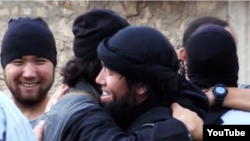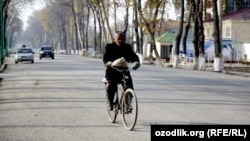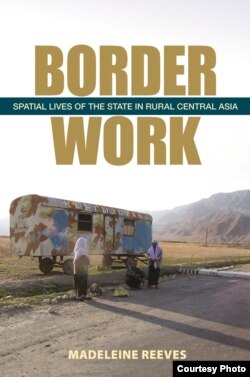
Citizens of Central Asia seem to be present wherever a Sunni Muslim group has declared jihad.
Uzbeks, in particular, but also Tajiks, Kyrgyz, Kazakhs, and Turkmen have joined groups in nearby Afghanistan and Pakistan and also further away, in Yemen, Syria, and Iraq.
Jihadist groups highly value these Central Asian recruits, and there is incentive for Central Asians to join.
RFE/RL’s Turkmen Service organized a panel discussion to examine Central Asia’s militants -- what makes them desirable to various jihadist groups and what stirs the desire of some Central Asians to leave home and wage jihad.
Turkmen Service Director Muhammad Tahir moderated the talk.
Participating were Edward Lemon, a doctoral candidate from Exeter University in England who has conducted in-depth research on Islamic radicalization in Tajikistan; Jozef Lang, a Central Asian analyst at the Center for Eastern Studies in Warsaw and author of a number of articles on Central Asian militants, including “The Radical Militants of Central Asia”; and Joanna Paraszczuk, the author of RFE/RL’s new blog “Under the Black Flag,” which has been chronicling issues surrounding the Islamic State militant group. And I said a few things, naturally.
One of the greatest attributes of Central Asian fighters first became evident some 15 years ago when they appeared in Afghanistan and Pakistan’s tribal areas: They are literate.
A benefit of decades of Soviet rule was a literacy rate of some 97 percent. That is certainly one of the highest rates among Muslim countries. In neighboring Afghanistan, for example, the literacy rate is about 30 percent.
The Uzbeks from the Islamic Movement of Uzbekistan (IMU) gained a reputation as the chief bomb makers in Afghanistan and Pakistan’s tribal areas. They were able to read manuals on mixing explosives and building bombs.
As Lang said, these Uzbeks “teach…how to construct IEDs and other explosive devices, which is the technical knowledge needed by the Taliban.”
Lang noted that the original IMU leader, Juma Namangani, was a soldier in the Red Army during the Soviet occupation of Afghanistan. Namangani became an Islamic militant and used his Soviet military training to great effect in Tajikistan’s civil war, brief insurgencies in Central Asia’s Ferghana Valley, and in the service of the Taliban.
Lang said some of the new Central Asians recruits fighting abroad have some military background. There are also those who have been fighting in Afghanistan and Pakistan for years and now have ample tactical battlefield experience.
The IMU took part in the well-coordinated June attack on the Karachi airport that left 36 people dead, including the 10 attackers.
Paraszczuk also noted the Central Asians are good with social media and that that experience is now working in support of the Islamic State militant group.
“The major Uzbek group in Syria has a website and a video channel and a Twitter account, for example,” Paraszczuk said.
The IMU has been running a website for a decade now and has been regularly posting videos from Pakistan’s tribal area.
Lemon said the Central Asians now supporting IS militants are helping send IS propaganda back to the former Soviet Union.
“They're using VKontakte, they're using Odnoklassniki -- the main Russian-language social networks. They're using videos and the social media very effectively,” Lemon said.
Certainly, any militant group would be looking to recruit more members, but all the panelists agreed there seems to be a preference for bringing in Central Asians.
But why are the Central Asians interested in joining militant groups?
The obvious answer is a sense of religious duty, helping out fellow Muslims.
But it is unclear how strongly that call resonates among the Muslims in Central Asia. Those who left Central Asia and went to Afghanistan and Pakistan were certainly aware that an austere lifestyle awaited them.
For those joining IS, the picture is more complicated.
Various figures have been given for how many have gone to Syria, with the most alarmist estimates, mainly from Russian sources, putting the number as high as 5,000. The roundtable panelists believe the number of Central Asians fighting in Syria and Iraq is closer to about 1,000.
Even then, it remains unclear how many actually packed their bags in Central Asia and left for Syria. Lemon pointed out that of the militants from Tajikistan he profiled, “the vast majority were recruited in Russia, so most of them…went to Russia in search of work, were radicalized in Russia, and then moved to Syria.”
There are millions of Central Asians in Russia working as migrant laborers. Lemon said that in the cases of the Tajik militants he researched, “Most of these young men, before going to Russia, were not religious. They were not particularly pious…”
Many of the Central Asians now in Syria and Iraq were first in Russian cities, part of the army of migrant laborers sweeping Russia’s streets, shoveling snow, and breaking ice off rooftops, then likely spending their nights in crowded quarters occupied by dozens of other migrant laborers.
Paraszczuk said the living conditions for migrant laborers contrast strongly with the propaganda the IS offers.
“What I'm seeing is -- not just with Central Asians but also with other militants from the former Soviet Union -- is that people are being given a sense of mission," she said. "If before they were a nobody in Moscow with a menial job, they're now someone who's leading a brigade, they're taking part in an operation to liberate a town…”
And Lemon added that for some Central Asians there is a certain romance about fighting in the Middle East, an area from which Central Asia was entirely cut off during its time as part of the Soviet Union.
Plus, there’s the money.
The chairman of Kyrgyzstan’s State Committee for National Security, Taalai Japarov, said in September that he had heard Islamic State militants were offering $1,000 a day to fighters.
That figure is unlikely, but based on what some of these Central Asian militants are saying, IS pays significantly more than the average migrant laborer makes in Russia. And, of course, in Syria and Iraq they are given their own rooms, they believe themselves to be heroes -- mujahedin -- as opposed to being looked down upon and worrying about being beaten, or worse, by nationalists in Russia.
-- Bruce Pannier








